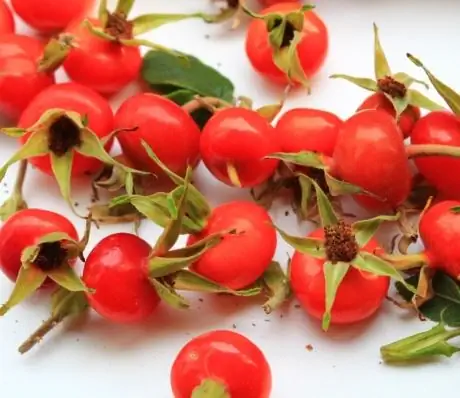- Author Rachel Wainwright [email protected].
- Public 2023-12-15 07:39.
- Last modified 2025-11-02 20:14.
Raspberries
Raspberries are one of the most delicious medicinal berries. Did you know that these berries are not only red, but also white, and even black?
The ratio of BJU in the product

Source: depositphotos.com How to burn 52 kcal?
| Walking | 13 minutes |
| Jogging | 6 minutes |
| Swimming | 4 minutes |
| A bike | 7 minutes |
| Aerobics | 10 min. |
| Household chores | 17 minutes |
Description
Raspberry belongs to plants of the genus Rubus, the Pink family. It is a perennial shrub, reaching a height of one and a half meters. The shrub shoots are covered with small thorns and edible fruits.
The stems of the shrub are erect, with oval leaves of a dark green color, which are covered with fine hairs below. Raspberry blooms with white flowers, collected in small racemose inflorescences, which are located in the axils of the leaves at the tops of the stems.
The berry comes from the countries of Northern Europe. Wild bushes can be found in ravines, dark forests, and on river banks. Raspberries are cultivated in many countries, mainly in Russia, America, Serbia and Montenegro.
Wild raspberries have been known since the days of Ancient Rome and Greece. For the first time, the mention of this shrub as a garden plant occurs in manuscripts dating back to the 3rd century BC. In the 16th century it began to be bred in Western Europe, and from the 18th century in the United States.
Judging by how often this berry is mentioned in folk tales, tales and legends, it played an important role in the lives of peasants. Because of its extraordinary taste, people associate the berry with something pleasant. How often do people say when they want to emphasize that someone is living well: "He has no life - raspberries!"
Raspberries are small hairy drupes with a mild sweet taste and pleasant aroma. The most common is the red raspberry variety, whose color range can range from maroon to light pink. But there are varieties of white raspberries, with yellow berries, as well as black - ezhemalin. Usually, wild raspberries have smaller berries than garden varieties, but the taste and aroma are much richer.
Raspberry fruits are used in cooking and folk medicine. Berries are eaten fresh, canned, jam and syrups are made from them, and dried. They make juice, compotes, jelly, baby puree, jelly and fruit drinks. Raspberry juice is used in the preparation of sweet dishes - yoghurts, creams, desserts, sweets, cottage cheese. Raspberries make an excellent filling for pies, they are added to cakes and pastries. If fresh raspberries are frozen, they will be stored for a long time without losing their valuable qualities.
Composition and calorie content of raspberries
100 g of fresh raspberries contain 85.75 g of water, 6.5 g of fiber, 1.2 g of proteins, 5.45 g of carbohydrates, 0.46 g of ash, 0.65 g of fat; vitamins: A, B1, B2, PP, B5, B9, C, E, K, P, B4; macronutrients: phosphorus, magnesium, calcium, sodium, potassium; trace elements: selenium, copper, iron, manganese, copper.
The calorie content of raspberries is low and amounts to about 52 kcal per 100 g.
Useful properties of raspberries
The main benefits of raspberries are for colds, acute respiratory infections, tonsillitis. This is due to the fact that the berries contain salicylic acid - a strong antipyretic and diaphoretic. Therefore, the properties of raspberries include a decrease in body temperature, and, moreover, without the side effects inherent in most drugs. In particular, wild raspberries have antipyretic properties. For medicinal purposes, dried fruits are brewed and drunk as tea. The diaphoretic properties of raspberries are also useful for hypertensive patients to lower blood pressure.

In addition, the benefits of raspberries are antiemetic, anti-inflammatory, antitoxic, hemostatic, analgesic properties. Regular consumption of berries in food has a beneficial effect on the condition of the skin, due to the high content of B vitamins. In some diseases of the intestines, stomach and kidneys, as well as atherosclerosis and anemia, raspberries are also useful. It is especially appreciated due to the fact that, even after heat treatment, it retains most of its useful properties, therefore, raspberry jam is considered to be as useful as fresh berries.
The benefits of raspberries lie not only in the fruits, but also in the leaves. In folk medicine, they are used to stimulate the muscles of the uterus and as a diuretic.
You should know that it is not recommended to use raspberries with gout and nephritis.
YouTube video related to the article:
Found a mistake in the text? Select it and press Ctrl + Enter.






